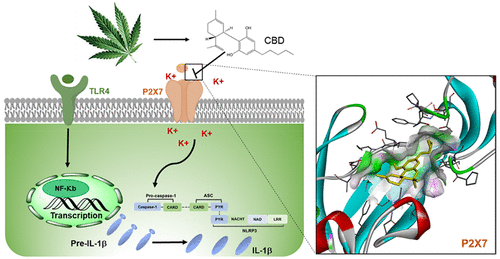当前位置:
X-MOL 学术
›
J. Nat. Prod.
›
论文详情
Our official English website, www.x-mol.net, welcomes your
feedback! (Note: you will need to create a separate account there.)
Inhibitory Effect of Cannabidiol on the Activation of NLRP3 Inflammasome Is Associated with Its Modulation of the P2X7 Receptor in Human Monocytes.
Journal of Natural Products ( IF 3.3 ) Pub Date : 2020-05-06 , DOI: 10.1021/acs.jnatprod.0c00138 Chang Liu 1 , Hang Ma 1 , Angela L Slitt 1 , Navindra P Seeram 1
Journal of Natural Products ( IF 3.3 ) Pub Date : 2020-05-06 , DOI: 10.1021/acs.jnatprod.0c00138 Chang Liu 1 , Hang Ma 1 , Angela L Slitt 1 , Navindra P Seeram 1
Affiliation

|
Cannabidiol (CBD), a phytocannabinoid, has been reported to have anti-inflammatory effects associated with NLRP3 inflammasome activation, but its mechanism of anti-inflammasome action remains unclear. Herein, we report CBD’s effect on NLRP3 inflammasome activation and its modulation of P2X7, an inflammasome activation-related receptor, in human THP-1 monocytes. CBD (0.1, 1, and 10 μM) exerted anti-inflammasome activity in LPS-nigericin-stimulated THP-1 monocytes by reducing media IL-1β concentration (by 63.9%, 64.1%, and 83.1%, respectively), which was similar to the known NLRP3 inflammasome inhibitors oridonin and MCC950 (16.9% vs 20.8% and 17.4%, respectively; at 10 μM). CBD (10 μM) decreased nigericin-alone- and nigericin-lipopolysaccharide-induced potassium efflux by 13.7% and 13.0%, respectively, in THP-1 monocytes, strongly suggesting P2X7 receptor modulation. Computational docking data supported the potential for CBD binding to the P2X7 receptor via interaction with GLU 172 and VAL 173 residues. Overall, the observed CBD suppressive effect on NLRP3 inflammasome activation in THP-1 monocytes was associated with decreased potassium efflux, as well as in silico prediction of P2X7 receptor binding. CBD inhibitory effects on the NLRP3 inflammasome may contribute to the overall anti-inflammatory effects reported for this phytocannabinoid.
中文翻译:

大麻二酚对 NLRP3 炎症小体活化的抑制作用与其对人单核细胞中 P2X7 受体的调节有关。
据报道,大麻二酚 (CBD) 是一种植物大麻素,具有与 NLRP3 炎症小体激活相关的抗炎作用,但其抗炎小体作用机制仍不清楚。在此,我们报告了 CBD 对人 THP-1 单核细胞中 NLRP3 炎性体活化及其对炎性体活化相关受体 P2X7 的调节的影响。CBD(0.1、1 和 10 μM)通过降低培养基 IL-1β 浓度(分别降低 63.9%、64.1% 和 83.1%)在 LPS-尼日利亚菌素刺激的 THP-1 单核细胞中发挥抗炎小体活性,这是相似的与已知的 NLRP3 炎性体抑制剂冬凌草素和 MCC950 相比(分别为 16.9% 和 20.8% 和 17.4%;在 10 μM 时)。在 THP-1 单核细胞中,CBD (10 μM) 分别降低尼日利亚菌素和尼日利亚菌素脂多糖诱导的钾流出 13.7% 和 13.0%,强烈建议 P2X7 受体调节。计算对接数据支持 CBD 通过与 GLU 172 和 VAL 173 残基的相互作用与 P2X7 受体结合的潜力。总体而言,观察到的 CBD 对 THP-1 单核细胞中 NLRP3 炎性体活化的抑制作用与钾流出减少以及 P2X7 受体结合的计算机预测有关。CBD 对 NLRP3 炎性体的抑制作用可能有助于报告这种植物大麻素的整体抗炎作用。以及 P2X7 受体结合的计算机预测。CBD 对 NLRP3 炎性体的抑制作用可能有助于报告这种植物大麻素的整体抗炎作用。以及 P2X7 受体结合的计算机预测。CBD 对 NLRP3 炎性体的抑制作用可能有助于报告这种植物大麻素的整体抗炎作用。
更新日期:2020-06-26
中文翻译:

大麻二酚对 NLRP3 炎症小体活化的抑制作用与其对人单核细胞中 P2X7 受体的调节有关。
据报道,大麻二酚 (CBD) 是一种植物大麻素,具有与 NLRP3 炎症小体激活相关的抗炎作用,但其抗炎小体作用机制仍不清楚。在此,我们报告了 CBD 对人 THP-1 单核细胞中 NLRP3 炎性体活化及其对炎性体活化相关受体 P2X7 的调节的影响。CBD(0.1、1 和 10 μM)通过降低培养基 IL-1β 浓度(分别降低 63.9%、64.1% 和 83.1%)在 LPS-尼日利亚菌素刺激的 THP-1 单核细胞中发挥抗炎小体活性,这是相似的与已知的 NLRP3 炎性体抑制剂冬凌草素和 MCC950 相比(分别为 16.9% 和 20.8% 和 17.4%;在 10 μM 时)。在 THP-1 单核细胞中,CBD (10 μM) 分别降低尼日利亚菌素和尼日利亚菌素脂多糖诱导的钾流出 13.7% 和 13.0%,强烈建议 P2X7 受体调节。计算对接数据支持 CBD 通过与 GLU 172 和 VAL 173 残基的相互作用与 P2X7 受体结合的潜力。总体而言,观察到的 CBD 对 THP-1 单核细胞中 NLRP3 炎性体活化的抑制作用与钾流出减少以及 P2X7 受体结合的计算机预测有关。CBD 对 NLRP3 炎性体的抑制作用可能有助于报告这种植物大麻素的整体抗炎作用。以及 P2X7 受体结合的计算机预测。CBD 对 NLRP3 炎性体的抑制作用可能有助于报告这种植物大麻素的整体抗炎作用。以及 P2X7 受体结合的计算机预测。CBD 对 NLRP3 炎性体的抑制作用可能有助于报告这种植物大麻素的整体抗炎作用。











































 京公网安备 11010802027423号
京公网安备 11010802027423号